Posted in Uncategorized | Tagged build in Spain, carbon, construction in Spain, eco, eco home, eco house, geothermal, Green architecture, passive, photovoltaic, solar | Leave a Comment »
Click here to take this quiz. It only take a couple of minutes. For everyone who does they donate $2 to Haiti. Also lots of good information here about climate change and deforestation.
Posted in Uncategorized | Tagged carbon emmissions, climate change, deforestation, sustainable development | Leave a Comment »
Below is some analysis, right up to date, about changes in the property market in Spain and in particular how foreigners are buying again, especially the Bristish, and developers are finding finance again.
In the last quarter of 2009, foreign residents in Spain bought 7,340 residential properties, 21% more than in the previous quarter and 11.8% more than in the same quarter of the previous year, according to figures from the Ministry of Housing.
Property sales have finally increased once again after eleven consecutive quarters of decline. Between October and December of 2009, there was an increase of 4.1% in this key statistic which meant the first year-on-year rise since the end of 2006.
The rise of almost 20% in property sales in February, 2010, as a yearly rate since 2008, has raised hopes in the housing sector. The majority of experts consulted confirm that these positive figures are a reflection of the drop in prices, low rates of interest, the expectant hike in VAT and the end of tax relief. Although some of these strengthening factors cannot last in the long term, they will be replaced by other equally effective factors.
These experts affirm that the housing market will pick up soon, much quicker than expected, in line with the increase experienced in the second quarter of 2010 and in a much more discernable way during the remainder of the year. However, it will not show a total recovery as the main problem in the sector is the illiquidity of the amount of building plots, although there are now financers who are prepared to begin new projects and, above all, to once again finance responsible building developers.
In the days leading up to Easter, estate agents specializing in second homes claim an increase of 50% in requests from the British interested in their real estate offers, in particular along the Costa del Sol and in the Balearics.
Source: IET www.iet-tourspain.es
Posted in Uncategorized | Tagged building plots spain, estate agents spain, foreigners in spain, housing spain, property market spain, property prices spain | Leave a Comment »
Posted in Uncategorized | Tagged eco, eco building, eco home, energy efficiency, green building, insulation, low carbon, sustainable, sustainable architecture | Leave a Comment »
Posted in Uncategorized | Tagged build in Spain, carbon, construction in Spain, eco, eco home, eco house, geothermal, Green architecture, passive, photovoltaic, solar | Leave a Comment »
Thank you for watching
Posted in Uncategorized | Tagged build in Spain, carbon, construction in Spain, eco, eco home, eco house, geothermal, Green architecture, passive, photovoltaic, solar | Leave a Comment »
Some of my friends (chicken littles mainly) think I have gone mad starting an architectural construction company, or indeed any business, in Spain in the current market. Actually the timing is perfect for many reasons and if I can just go off topic for a brief moment. People don’t buy or sell houses for the most part because there is or isn’t a recession. They buy and sell houses because they get married, divorced, have children, someone dies, they get a new job or they retire. None of this has stopped happening.
There are a hundred and one other reasons why the timing is right for us but this article is about social media marketing. And one of the reasons why now is a good time for us to start our business is that right now (August 2009) social media marketing is an open field. Very few people are using it and even fewer people are using it effectively. Social Media Marketing is how we are going to distribute our service / product.
Social Media Marketing is absolutely great because:
1. It’s free
2. It filters out the cads and blaggards
3. It requires total self expression so it’s fun
4. It requires you not ever to pitch or sell your service or product which makes some people uncomfortable
Before we get into it let me explain what it is in a way you’ll understand.
It’s Like Going Down The Pub
The world of social media is like a big jolly pub. It’s a busy place with a great atmosphere. There are all sorts of people there: shy, loud, thoughtful, serious, trivial, introvert and comic.
There are plenty of people lurking around in the background who don’t do or say much. Perhaps they’re too shy. Perhaps they don’t know how to start a conversation. Perhaps they just like to watch what’s going on.
Then there are people who walk in and then walk out again without saying anything.
Then there are the brash types who come barging in noisily stand on the table and shout at everyone and tell them to buy what they’re selling. The pub falls silent while everyone freezes in horror at the social gaff. Eventually they leave, leaving the place littered with their business cards, because no-one talks to them. Everyone is aghast at the goofiness of the blundering fool.
Then there are people who sidle up to the bar and introduce themselves affably, tell a joke and make us laugh, ask us how we are and listen to the answer, make interesting conversation, buy everyone a drink when it’s their turn. As you meet them every day you get you know them quite well. You become friends. You know how they make their living, you know about their family, what they like to do for fun. The most popular people in the pub are keen to make a contribution, help out other people, buy a round of drinks, organize the charity do, look after people, and get their round in.
The point is it’s an active community. Useful, helpful, authentic people are popular and make friends.
Now, when you need some advice you ask your mates down the pub. If the people you know can’t help you directly they’ll know someone who does. This pub has a really effective grapevine. The advice could be anything from who’s the best web designer for me, who can make me a special engagement ring, to who can build me a high quality eco friendly home? And when you receive the advice, because it’s from someone you know and like and trust, the chances are you’ll take it and say thank you. If you don’t you may come back to that person later or recommend them to someone else.
Now let’s say one of your mates down the pub is a web designer and you need a website. What kind of relationship do you have now with him? One of trust. If he’d try to sell you his services as a web designer before you made friends, or before he gave you some impartial advice on something else, would you feel the same way? No way. Just like in the pub you don’t try to sell your mates life insurance.
And in the unlikely event that he’s a useful member of your community but turns out to be a crap web designer or worse runs away with your money will he last long in the community? Not a millisecond.
Ok so let’s move on a bit. Can a business walk in the pub and be part of the community? No. A business isn’t a person. It’s that simple. There are plenty of businesses wasting their time and money with Facebook accounts and You Tube Accounts boasting about their stuff and no one is paying a blind bit of notice because a business isn’t a person and you can’t chat to them or see pictures of their children. (See footnote)
How do I Get Results?
Ok so now you know it’s a pub let’s look at actually how to get results in Social Media Marketing. There are four cornerstones to being effective and if you do each one of these correctly and you are persistent over time you will get results. It’s inevitable.
1. Personal Branding
2. Daily Activity
3. Content
4. Keyword Research
Personal Branding
This is my favorite of the four cornerstones and the thing that really excites me because you have to be authentic, have integrity, and make a genuine contribution if this is going to work for you. You can’t hide behind the company logo, slogan, rules or whatever. A few people in the corporate world seem to change their personality at the office and behave as if they are acting in a film and someone has written them a bad script. Forget about all that. Don’t pose or try to be cool. It’s essential that you are authentic. In fact I would go much further and say it’s essential that you are fully self expressed.
And best of all you never have to “close a sale”. That is the language of dinosaurs rapidly becoming extinct and you will only see fossilized versions of this anywhere in the commercial world in a couple of years let alone down the pub. So if your nature is pushy, tricky, or scratchy then start celebrating because this is your opportunity to become a great person. Either that or forget about ever selling anything and go back to your miserable life. Customer really is king now in a way he never has been before and none too soon in my opinion.
Let me underscore this point. This only works if you are genuine in what you have to offer (i.e. it’s worth more than the money you charge for it) and you yourself have total integrity.
So to be successful you are creative fun playful and authentic. If you’re not that by nature then become it. Remember this is not about hard work and it’s not about manipulating people and it’s not about being competitive. It’s simply about making yourself visible to people who are already looking for someone exactly like you. Do this well and you will stand out from the crowd because there are so many people at the moment who are shouting in the pub and trying to use social media to manipulate people. It won’t work.
Daily Activity
Go to the pub every day and have fun. Walk around introduce yourself to be people. Introduce people you know to other people you know that they may find useful. Network. Don’t keep secrets. Give away real value especially where your competitors are hiding things. You’ll blast them out of the water. Make comments on people’s blogs, photos, articles, answer questions on forums (forums are very powerful because you come over as an expert ……assuming you are one), share information, and help people. Do this consistently everyday for months and you will become not only visible but irresistibly attractive to people who are already looking for you. I never said this was effortless; free and fun yes but not effortless.
Content
There’s nothing new about this one. Internet marketing has always been about content. It should be informative, entertaining, personal, even quirky. You should make some content of your own which can be articles or videos. But the great thing is that you don’t absolutely have to have original content. There is masses of content out there and most of its crap. You can offer a really useful and attractive service by filtering out the rubbish. I might like to know that if I visit your You Tube Channel or your Blog that I am going to see the best most relevant material and I won’t ever see anything which is a waste of time.
Keyword Research
This is the killer factor that can get you on the first page of Google without SEO or PPC. No one knows the Google algorithm and in any case they’re always changing it. But we do know that Google favours all the social media sites. If you get a lot of clicks on your blog and if people leave a lot of comments on your content Google will notice that and you will quite quickly move up the ranks where you become more visible, so more people click on you in a positive feedback cycle.
Take a look for yourself. I have just done a search on Google for energy efficient homes. Number 4 took me to a page of videos on various video-sharing sites. I clicked on the first video and I saw a very informative video about awnings and how they improve the energy efficiency of your home. It was made by a guy called Michael Sahlin who clearly knows what he is talking about. Right at the end of the video I saw his tel number and his website address. He never once pitched to me. If I want an awning to improve the energy efficiency of my home the chances are I will contact him and ask for his advice. This is how you do it.
Notice I didn’t get straight to his website but straight to his video. If I like him I will find his website address there. This is what he did and you can do the same for very little money, just time a willingness to persevere, and a can-do attitude.
Notice also he gave me some useful information without asking for anything in return. Just like a good friend. This is key.
The next bits a bit technical so bear with me and if you’re really going to do this take the time to research what I am saying so confirm that I am right.
You will need an account with wordtracker. You get 7 days for free, which in my experience isn’t long enough. You are going to have to pay wordtracker one way or another because this is an ongoing thing not a one off. But it’s a maximum of $50 a month you can suspend your account and come back to it and its well worth it.
You are looking for keywords that are popular but not widely competed for. Wordtracker tells you how to do this and there are some helpful articles on their website. In other words you are looking for the words and phrases that people actually search for in Google but which not many websites have content on.
Then, step two, is to create some content around that keyword. Make sure it’s relevant, informative and entertaining. Then simply post it up on all your social media sites making sure that the keyword phrase is in the URL, and in the title of your content, and make you use it in the description and the tags. Tell a few people down the pub and some of them will have a look and leave a comment especially if you habitually leave comments on their material and Bob’s your aunties husband and the worlds your lobster. Give it time and you will rank highly for that keyword or phrase on the Google search engines.
It’s like everyone in the pub knows who you are. You’re like a magnet for your ideal prospects who come to you asking for your expert advice and who are happy to pay for it.
More Please
I have a list of social media sites divided into Media Sites, Bookmarking sites, Content Sharing Sites, Media Sharing Sites and Other. I am happy to share this with anyone who gets in touch with me. I am also happy to clarify any of the issues discussed.
Thomas Power articulates a lot of these on his series of You Tube videos eg:
Footnote: I think the real point here is that the internet has changed forever the relationships we have with our customer. Some businesses are using social media marketing effectively perhaps by making funny or quirky videos on You Tube or really courting the relationship with their clients. Thomas Power explores this in a series of videos.
Posted in Uncategorized | 2 Comments »
Introduction

It’s quite possible you’re already familiar with the idea of a ‘living wall’ – maybe you’ve seen old properties enveloped with vines, you might have seen the art project currently underway in Rio de Janeiro (see the picture above), or perhaps you’ve just been unlucky enough to witness a mildew outbreak in your house! These are all examples of living walls, but don’t touch on the ecologically minded living walls, a more modern concept which is becoming increasingly popular within the circles of architecture and design.
Eco Living Walls – A Definition
Definition from www.knowledgerush.com:
“A living wall is a vertical garden. The plants grow in compartments on a porous vertical wall. The water drips down, and may feed moss and vines, other plants, some insects and bacteria. The water is captured at the bottom of the wall in a pool or pond to be re-circulated to the top.” (http://knowledgerush.com/kr/encyclopedia/Living_wall/)
Definition from www.wikipedia.com:
“A green wall is a wall, either free-standing or part of a building, that is partially or completely covered with vegetation and, in some cases, soil or an inorganic growing medium. They are also referred to as living walls, biowalls, or vertical gardens.” (http://en.wikipedia.org/wiki/Living_wall)
Eco living walls – exterior applications
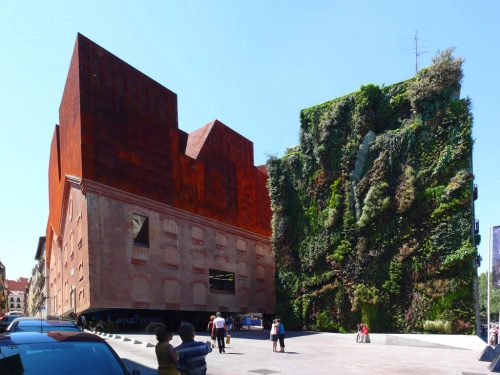
The use of living walls in a building’s facade is an increasingly popular practice amongst architects, with examples popping up around the world, from Spain to the US to South Korea. But, apart from the obvious, what makes these vertical gardens green?
One of the main environmental problems in cities arises from the huge surface areas of concrete, asphalt, and other similar materials created by densely packed buildings and extensive road networks. These materials absorb radiation from the sun (heat energy) very efficiently, so the very fabric of the city is heated, and this energy is subsequently re-radiated, heating the air further. As a result of these ‘urban heat islands’, cities are often 3-4 degrees hotter than surrounding rural areas. The main knock-on effect this has for the environment is the increased use of mechanical cooling systems.
Eco living walls can help to combat this urban heat island effect, as can green roofs, since plants and other greenery absorb far less heat than massive construction materials. The temperature of the building’s fabric is therefore lower, so as a result its contribution to the heat energy contained in the surrounding air is lower. Problem solved!
‘Living facades’ can also have a positive effect on a building’s internal environment. In winter months the air cavity between the living wall and the building’s structure acts as an extra layer of insulation, and the living wall itself acts as a barrier against winds. The latter is especially useful since, in winter, wind chill factor can account for up to a third of heating demands. In the summer, the living wall provides increased shading for the fabric of the building hence one will often see them used on South and West facing walls (in the Northern Hemisphere that is!).
Eco living walls – interior applications
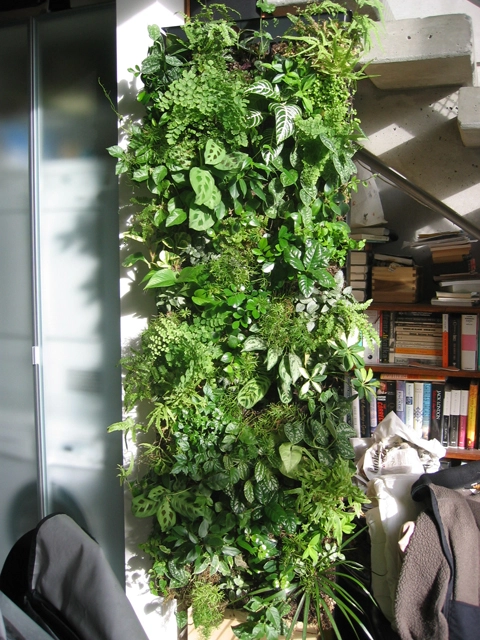
As you can see from the image above, eco living walls aren’t just limited to exterior applications! There is a growing demand for living walls inside buildings, the effects of which can also be highly beneficial to the living environment. With the correct selection of plants, a living wall can actually remove or trap dust, toxins and other unhealthy contaminants from the air inside a building. This is a great, natural way to achieve excellent air quality, and a good method to help prevent ‘Sick Building Syndrome’ (yes, this does exist!) The filtering effect can be made more efficient if the air a building draws in can be passed directly over a living wall as it enters the building.
Most eco living walls built for interior applications consist of a vertical arrangement of plants or organisms supported by a simple irrigation system. These irrigation systems often feature a tank of water at the base of the wall, which has a cooling affect on the interior environment.
Depending on your choice of plants, your living wall can also become an ‘edible wall’ – sounds like something out of Willy Wonka’s factory! A lot of herbs, salad greens and other vegetable plants are suitable to use in living walls, so they can even help to cut your food bills!
And Finally…
Let’s not forget amongst all these green benefits, eco living walls are also beautiful. They are often received as works of art and provide excellent focal points both inside and outside buildings. So, they are good for the environment, good for your health, good for your food bills, and great to look at. Not bad for a few plants on a wall!
Bio
Written by Simon Thorpe, a 3rd year Architecture Undergraduate at Magdalene College, Cambridge. Simon spent 2 months in the summer of 2009 as an intern for Eco Vida, ecological architects and green building experts. Tel +34958126272, info@ecovida.co.uk, www.EcoVidaInternational.com. Contact Simon at simoncthorpe@hotmail.co.uk
Posted in Green architecture | Tagged eco, eco living walls, Eco-friendly building, Eco-friendly home, Eco-friendly house, Ecological building, Ecological home, Ecological house, Granada Green house, green, green building in Spain, green facade, green home, Green house, green walls, living facade, living walls, sus, sustai, Sustainable building, Sustainable home, Sustainable house | Leave a Comment »
Introduction
In this article I’ve put together 10 of my favourite eco houses from around the world. As you’d expect with the current popularity and poignancy of terms like ‘green homes’, ‘eco friendly buildings’ and ‘sustainable construction’, there are hundreds of houses to choose from when compiling a list like this, which is a great thing! Because of this I realise I’ve hardly scratched the surface with my research and I’d love to hear any feedback, comments, criticisms or suggestions on the buildings I’ve selected, as well as any you feel I’ve left out…
The Eco Arch, Kent, England
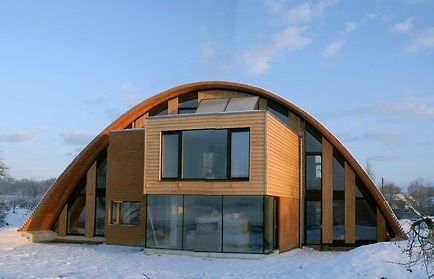
This rather iconic-looking home, shown on Channel 4’s Grand Designs series in the UK, features an unsupported parabolic arch made up of thousands of tiny clay tiles. This unprecedented feat of engineering is also highly insulated and is covered with layers of gravel and soil to allow wild grasses and flowers to seed. Underneath it, a super air-tight modern home is laid out to face the huge south facing windows, which harness the energy of the sun to heat a heavy ‘eco-concrete’ floor slab. This “creative, risk-taking and groundbreaking” building is an architectural first and we can learn a lot from it!
More information at…
The Active House, Lystrup, Denmark
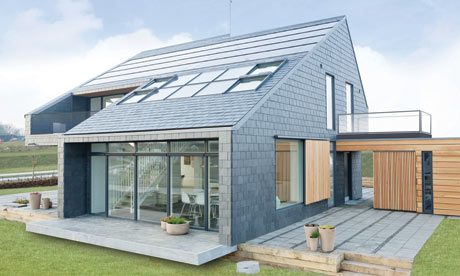
With a cheeky play on words, this house is looking to match and surpass the standards of the ‘Passiv Haus’ widely used around parts of Europe. The aim of the building is to provide a zero-carbon eco home without compromising on supreme comfort and usability, which is an idea that I love, and something I definitely believe to be achievable. The house uses solar-generated electricity, solar heating and an advanced computer system which controls the interior climate, opening and closing windows according to the temperature, season and time of day. This technologically advanced design is really interesting as an alternative approach to the so far unquestioned passiv haus system.
More information at…
http://www.guardian.co.uk/environment/2009/may/21/active-house-denmark-zero-carbon
LivingHomes RK1, Santa Monica, USA
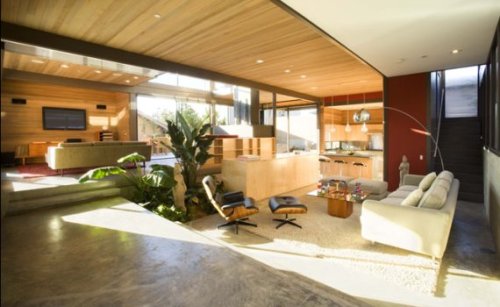
This house caused a pretty big response amongst the press and building worlds when it was build back in 2006, since it was the first house to receive a ‘Platinum Rating’ in America’s LEED sustainable design rating system. To be honest all the attention seems to be deserved – the home uses zero net energy and water, and produces zero net waste, carbon and emissions. Pretty impressive! This house is a model for the ‘RK1’ prototype offered by LivingHomes, a spacious 5-bedroom structure with options for customisation of finishes applied and technologies used.
More information at…
http://www.gearcrave.com/2008-07-21/the-best-of-modern-prefab-santa-monicas-livinghome/
Flow House Design Concept, New Orleans, USA
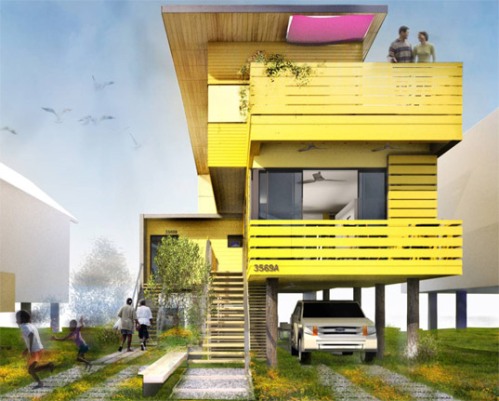
Intended for the Lower 9th area of New Orleans, devastated by hurricane Katrina, this design is brimming with sustainable design features. Photovoltaic roof panels, rainwater harvesting and ‘rain gardens’ act alongside passive design features that allow natural ventilation and plenty of daylight. What makes this project stand out is the ‘cradle to cradle’ design philosophy applied by architects William McDonough + Partners. This means that, once the building is no longer in use, all the materials used can either be recycled or returned to nature. Similarly admirable is the amount of attention the architects paid to ‘community design workshops’ to ensure the houses were really tailored to the local people. Great stuff.
More information at…
http://www.inhabitat.com/2009/07/13/william-mcdonough-partners-flow-house-in-new-orleans/
The Brooks Avenue House, Venice, USA
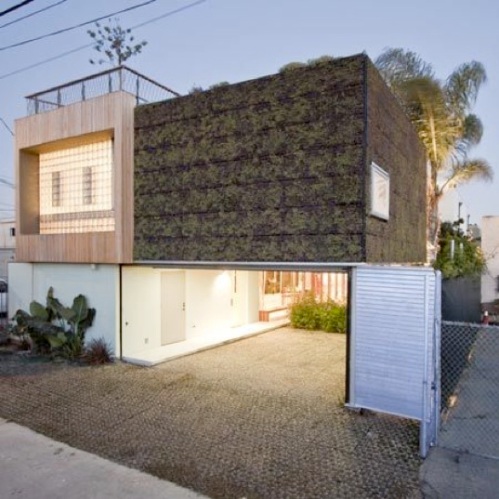
This modern Californian house extension takes the concept of green rather more literally than others! One section of the structure is covered on three sides with a living wall system, fed with captured rainwater and recycled domestic water. Above this the roof houses a highly productive vegetable garden, a nice alternative to popping to the shops every day for your fresh veg! There’s a strong connection between inside and outside, and the architecture harnesses principles of natural lighting and ventilation. Of course, all the other ‘sustainable boxes’ are ticked – the building is packed with solar panels, led lighting, low-flush toilets, and green materials.
More information at…
http://www.inhabitat.com/2009/08/19/the-brooks-ave-house-a-californian-study-in-green/
Residence Amongst Trees, Sydney, Australia
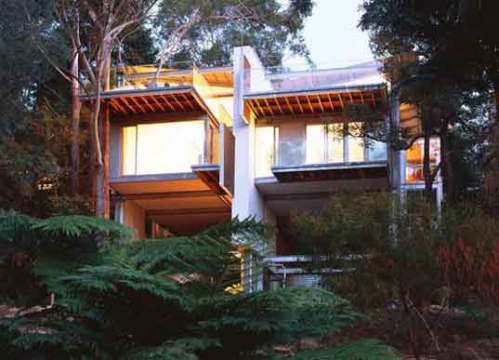
The beauty of this house for me lies in its delicacy in dealing with the surroundings. The thoughtful design carefully sits on 8 steel pillars amongst a host of council protected trees, and goes to such an extent to avoid disruption that it even features a 30ft eucalyptus tree growing through the deck. I can only imagine how tranquil it must be to live here, engulfed in nature. The house also has a unique ‘butterfly’ roof, which helps to harvest rainwater for the toilets, laundry, landscaping and gardening, and also allows natural light to flood into the upper floors. Perhaps that childhood dream of a treehouse wasn’t so fanciful after all…
More information at…
http://www.inhabitat.com/2007/11/30/living-lightly-among-the-trees-in-australia/
Hof Country Residence, Skakafjordur, Iceland
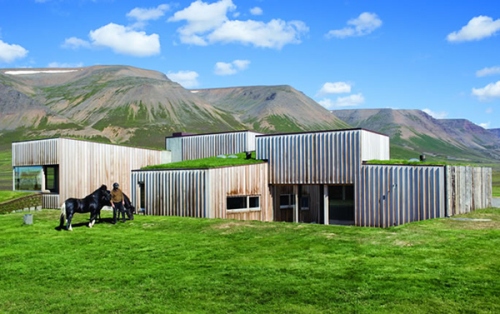
This beautifully creative country residence is said to be inspired by the landscape and climate of Iceland, and you can easily begin to see how when you look over the volumes gently rising from the ground, covered by the turf that their construction displaced. The architects, Studio Granada, find a wonderful harmony between rustic traditionalism and modern chic, juxtaposing concrete, oak and steel to great effect. Not forgetting their environmental obligations, the designers use the exposed mass of the concrete to stabilise internal temperatures, geothermal energy heats the house’s water supply, and the little electricity that is required is generated by hydroelectric sources. A thoroughly beautiful design.
More information at…
http://www.trendir.com/house-design/sustainable-house-in-iceland-grass-topped-house.html
The Woodman’s Cottage, Sussex, England
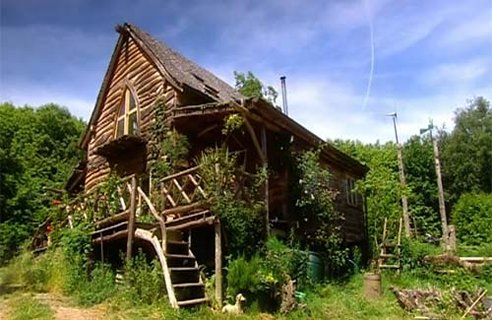
A homage to material sustainability, this humble woodman’s cottage, as feature on Channel 4’s Grand Designs show in the UK, is set deep amongst a sweet chestnut forest. The cottage is constructed entirely of locally sourced materials – the wooden frame is filled with recycled newspaper and straw bale insulation, which is then coated in clay and lime plaster. Instead of completely felling the trees, the owner coppices them to encourage rapid re-growth. The result is a charming yet simple rustic abode which presents a nice paradox to the more modern approach to ‘green architecture’.
More information at…
Villa UH1, Nacka, Sweden
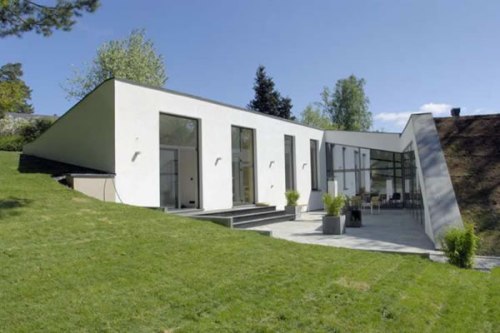
This Swedish bunker-style home represents a more contemporary, clean-lined approach to ecological house design. The design is apparently inspired by a WWII-era German bunker, but I definitely know which I’d rather live in! Comfortable, luxurious furnishings offset the sleek, minimal surface finishes to produce an inviting modern home. Let’s not forget it’s green credentials either – built into the side of a gently sloping hillside, and covered in a sedum living roof, the structure is highly insulated and thermally stable. The design also harnesses geothermal energy, with a heat pump providing heating and cooling for the entire house. Quite a contrast to the Woodman’s Cottage, but still a beautiful design!
More information at…
http://www.trendir.com/house-design/bunker-style-houses-eco-friendly-house-in-stockholm.html
Shelter House, Yport, France
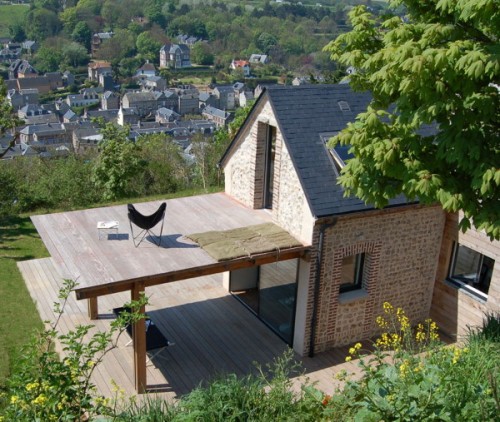
Do not be deceived by the simple, rustic appearance of this hillside residence in Normandy. Designed by Franklin Azzi Architecture with sustainability and the environment firmly in mind, the house exists independent of the national grid, generating it’s own electricity, heat and water using solar panels, geothermal energy and rainwater harvesting. All materials are sourced from within 100km of the site, and all are recyclable – of course! The design is quite beautiful and considered too, with two ‘wings’ protruding from either side of a more traditional-looking central structure. At present these wings provide shade and shelter on the lower level and terraces with incredible views on the upper level. However, they also give the opportunity for expansion should the owners require more interior space. One of my favourite aspects of this building is the subtlety of transition between interior and exterior – you can really imaging life spilling out onto the decks and terraces!
More information at…
http://www.trendir.com/house-design/eco-house-design-is-heavenly-complete-with-wings.html
And Finally…
So there you have it – 10 great eco homes from around the world! I think this collection is a great way of breaking any myths about what an eco homes is. It shows they can be any shape, size or style you like whilst still maintaining high standards of comfort, sustainability and environmental awareness. As technology moves forward and prices begin to fall it really is becoming difficult to justify not making your new-build house an eco-house!
Bio
Written by Simon Thorpe, a 3rd year Architecture Undergraduate at Magdalene College, Cambridge. Simon spent 2 months in the summer of 2009 as an intern for Eco Vida, ecological architects and green building experts. Tel +34958126272, info@ecovida.co.uk, www.EcoVidaInternational.com. Contact Simon at simoncthorpe@hotmail.co.uk
Poll
Posted in Green architecture | Tagged Eco-friendly building, Eco-friendly home, Eco-friendly house, Ecological building, Ecological home, Ecological house, Granada Green house, Granada Sustainable house, green building in Spain, green home, Green house, Sustainable building, Sustainable home, Sustainable house | 6 Comments »
Is pvcu the most toxic synthetic material to contaminate the environment man has invented or is it a safe material for window frames and superior to wood or aluminium?
In this article I am going to tell you what pvcu windows are, address the debate about whether they have a negative or positive effect on the environment, discuss their performance and compare it with the alternatives of timber and aluminum, and finally draw some conclusions and offer some advice.
pvcu Windows What Are They?
Let me quote Thermalframe, a company in New Zealand, which supplies pvcu windows. Here is their website http://www.epcsheerframe.co.nz/
“PVC windows, PVCu windows, uPVC windows and vinyl windows are the same thing – PVC windows. People from the USA or Canada tend to call them vinyl windows, people from UK / Europe tend to call them UPVC, or PVCu windows. With regard to strength of PVC windows, the vinyl windows of USA/Canadian origin tend to be lighter with less wall thickness than their UK / European counterparts and therefore are a little less suitable for the size of windows we tend to build in New Zealand. Either way, advancements in the polymer industry has seen these take over the world.”
“PVC stands for Poly Vinyl Chloride. The ‘u’ means that the PVC is unplasticised, i.e. rigid. PVC is a major thermoplastic material used in a wide variety of applications and products. The essential raw materials for PVC are derived from salt and oil. The electrolysis of salt water produces chlorine, which combine with ethylene, obtained from oil, to provide vinyl chloride monomer (VCM). Molecules of VCM are polymerised to perform PVC resin, to which appropriate additives are incorporated to make a customised PVC compound. PVC can be plasticised to make it flexible for use in flooring and vital medical products for example, or rigid “PVCu”, the U stands for “unplasticised” – which is used extensively in building applications including window frames.”
pvcu Eco Friendly or the Devil in Disguise?
For many people the major problem with vinyl is the negative effect its production and incineration has on the environment. The process creates significant toxins, including dioxin, one of the most toxic compounds known. For this reason, vinyl windows are often discouraged for “green” projects. Joe Thornton a research scientist at Colombia University wrote a paper in 2005 outlining the dangers and toxins associated with pvcu which can be found here:
http://www.healthybuilding.net/pvc/ThorntonPVCSummary.html
As you might expect Thermalframe, a company which distributes pvcu, window frames have a robust defense. Let me quote their website (which is http://www.epcsheerframe.co.nz/)
“Thermalframe is as conscious of the environment as you are.”Green” is not a fad; it is a way of life we must all adapt if our children are to have the same quality of life we now enjoy. The environmental impact of any product must be measured from cradle to grave, taking into account the impact of each phase of its life cycle. PVCu is a safe choice in all phases. PVCu requires substantially fewer resources to produce than metal alternatives. When PVCu is used as a substitute for wood precious hardwood forests are spared… the plentiful, replaceable pine is not suitable for windows. It would take quite a few hardwood trees to replace the 20-25 million PVCu windows installed in Britain. PVCu joinery lasts longer and needs little maintenance and no painting. The long life means fewer resources are needed to replace it later and the low maintenance spares the environment exposure to harsh chemicals involved with preservatives, paint and associated solvents. It is an environmentally friendly product composing 55% salt and is recyclable. Thermalframe PVCu joinery is all made from organic calcium based profiles and are completely lead-free.”
At the Centre for Alternative Energy in the UK (a registered charity) they have come down firmly in favour of wood. It’s interesting that Thermalframe the main proponents of PVCu windows only talk about PVCu being preferable to hardwoods and they may be right. But there are many other sustainable sources of timber frames. This is what the Centre for Alternative Energy say:- (here is a link to the full paper I am quoting from http://www.cat.org.uk/information/pdf/GlazingOver.pdf )
“Timber, uPVC or aluminium frames? If you are replacing windows, wood is the best option. There are many environmental problems associated with the manufacture of PVC. High levels of dioxins and other organochlorines are found around PVC plants and are released to the atmosphere on combustion. They’ve been linked with cancer, immune system damage and hormone disruption. Although manufacturing techniques are improving, disposal at end-of-life is still a problem.
PVC manufacture uses lots of energy; far more than wood production. Wood frames can last for over 50 years, and then be renovated rather than replaced. uPVC windows usually need replacing after a much shorter period. Although uPVC window manufacturers claim they are maintenance free, Dulux recently brought out a uPVC frame paint, recommended for use every 6 years! Aluminium manufacture involves a lot of energy use and pollution. The coatings on some frames make recycling difficult – not ideal for such a high value material, so look for anodized frames if you do choose aluminium.”
Another problem with pvcu is that it is relatively weak so the frames have to be quite thick reducing the glazing area and transmitted light. So pvcu isn’t suitable for large windows on this account alone. Another problem is vinyl’s tendency to expand and contract with normal temperature fluctuations which can cause loosening of seals and corner cracks.
Certainly aluminium frames on their own are not appropriate because they conduct heat with great efficiency and where used there are problems of condensation forming on the frame. However aliminium is strong and can be combined with wood or vinyl in a number of different ways to incorporate thermal breaks. These pictures illustrate how:-
http://www.efficientwindows.org/ftypes.cfm
The key message here is that the most earth friendly option is wood. The material comes from sustainable sources and it’s a strong low maintenance material. So for “green” projects wood is best. Aluminium is an option too where it is blended with other material to incorporate thermal breaks. The principal advantage is its strength for large windows.
So wood is best and the best timber framed windows are manufactured in Scandanavia where you can source splendid prefabricated ecologically friendly windows including triple glazed argon or krypton e-coated windows at reasonable prices.
Other Key Components in Energy Efficient Glazing
- Fitting: the quality of the seal and the workmanship here is critical to the performance of the window and the energy performance of the building. This is the most important factor of all. A bad window system well fitted is probably better than a good window system badly fitted. So be wise in your choice of fitter and by the way this applies to the whole building.
- Window panes: this is a massive area I will address in another article.
- Shading and Shutters: also a critical factor in the overall performance and the subject of another article.
- Placement and Orientation: also a key factor in the energy balance of the building.
And finally
Windows used to be considered the inevitable weak point in insulating your home. But with significant changes in technology over the last twenty years which allow light to pass through but not heat (or sound) this is no longer the case. Indeed these days you can have it all. You can have enormous windows which are pointed at the best views and you can have the internal layout that you want without compromising the energy efficiency of the building. It’s a question of getting the energy balance of the building right and a key part of this equation is the glazing. Watch this space for more information.
Bio
John Wolfendale is a director of Eco Vida, ecological architects and green building specialists. He graduated in Land Economy from Magdalene Cambridge in 1984, and has an additional first class degree in psychology. He has been a Chartered Surveyor for 23 years and lives with his Spanish wife and family in Granada, Andalusia, Spain. www.EcoVidaInternational.com
Posted in Uncategorized | Tagged harprenden windows, pvcu windows, pvcu windows and doors, pvcu windows andalucia, pvcu windows andalusia, pvcu windows costa del sol, pvcu windows Granada, pvcu windows spain | 3 Comments »




